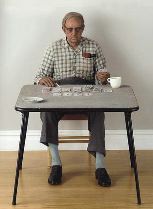
I was brought up cold out of my post-Christmas reveries yesterday morning by an article at artnet by Richard Polsky. He’s the guy that does the art market watch (i.e., auctions — secondary market) and the piece, a 2004 wrap up talking about how particular big name (brand name?) art was trending at auction — up, down or status quo — was like a hammer hitting home again and again about monetary value, worth and history.
Polsky’s comprehensive list of hotties past and present seemed to show most artists on the upward trend or even keel which spoke as much about the market being good for art as it did for the art being good. (image is Duane Hanson‘s “Old Man Playing Solitaire” (1973) which passed at auction in 2004. Polsky’s comment was that collectors were skittish about Hanson’s work because “living with another “person” is just too unnerving.”)
Money talks and whether or not these up-trending marketable artists are what will be remembered as Art in the 20th and 21st centuries is not clear. But Polsky’s piece clarifies in a moment how market forces advocate on their behalf.
Libby, to whom I confided my depressed state of mind, exhorted me to remember that most artists don’t make art with the secondary market in mind, being fueled by higher thoughts about making a significant art statement or a lasting thing of beauty. True, so true. In fact some artists make art without regard for the primary market!
Now I’ve always been jaded about art and commerce, to say nothing of the wheels of commerce in general. It’s my baby boomer, coming of age in the ’60s upbringing. But in addition, perhaps when I hit the Polsky article I was under the influence of a BBC costume drama Steve and I watched on video the night before: “The Way We Live Now.”

Based on an Anthony Trollope novel, the piece was about a get-rich scheme with gullible souls throwing money after what seemed a good idea then getting burned when it turned out someone was pocketing the money and not building the thing. With all the scenery and scenery churning acting (notably by David Suchet who played the main character), the four-episode potboiler was depressing for its truthfulness about the way the world works. So how could the art world be any different from this? Well of course it isn’t. It is the way we live now.
Oh, one more thing about that BBC production. The press was some mighty force in the piece. People were ever reading the papers which were not only giving them news but commentary and editorial content as well. It was in fact the press that was able to unmask the swindler and turn the tide of opinion. Hmmmm, that’s a positive note to end on.









